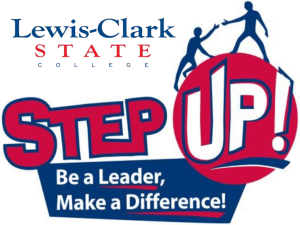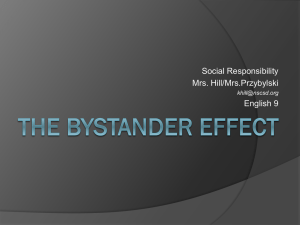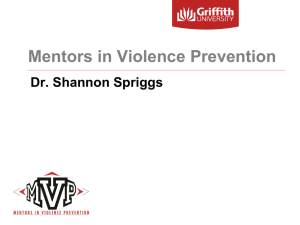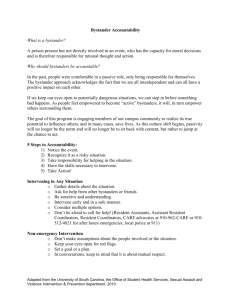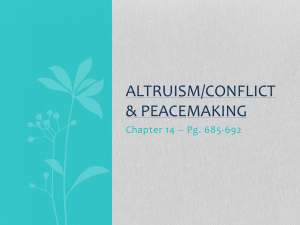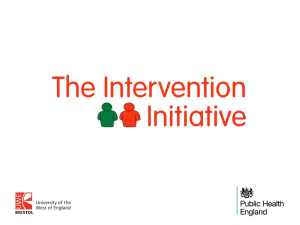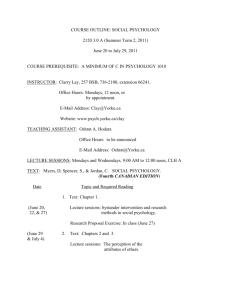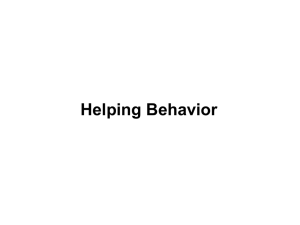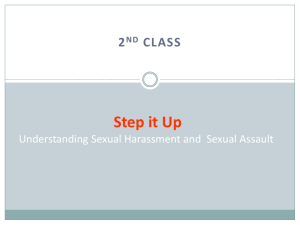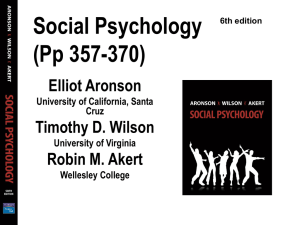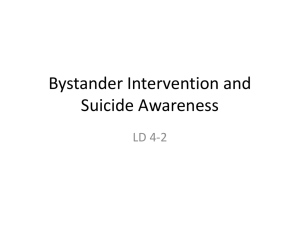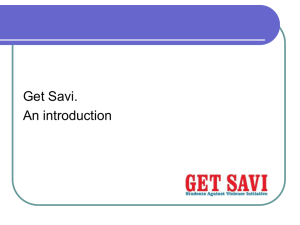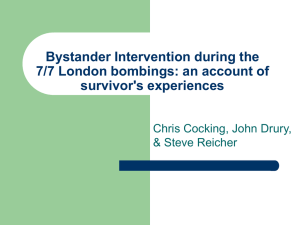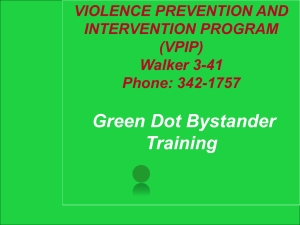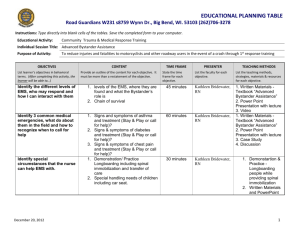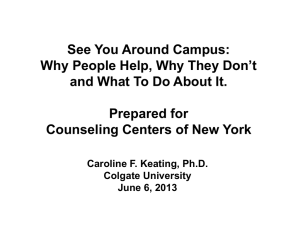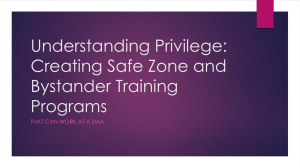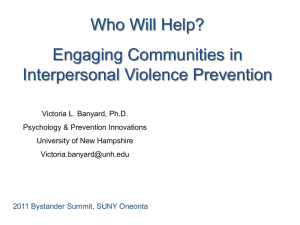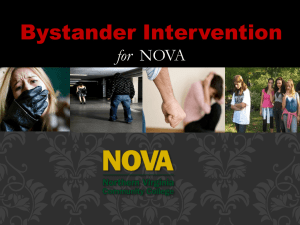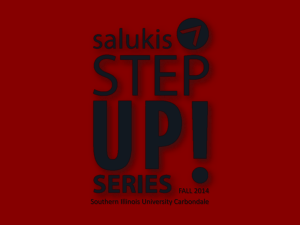STEP UP!
advertisement
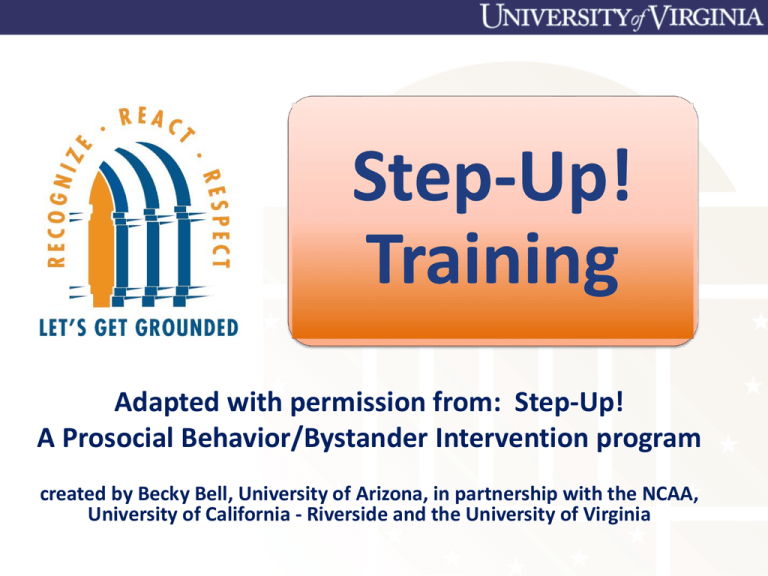
Step-Up! Training Adapted with permission from: Step-Up! A Prosocial Behavior/Bystander Intervention program created by Becky Bell, University of Arizona, in partnership with the NCAA, University of California - Riverside and the University of Virginia Step Up! Philosophy • Belief that people have pro-social values and want to live by them. • Respect for all participants and the process of change Step Up! Program Goals • Help participants recognize reasons why people may not intervene when another is in trouble • Empower participants to act on their values • Create a safer environment for everyone Step Up! Program Components • 1 ½ - 2 hour program • Teaching Techniques – Audience Response Technology – Video Clips – Small group discussion • Content – – – – Explain the bystander effect Review relevant research Provide strategies for reaching each of the 5 stages Population and topic –specific scenarios Step Up! Topics • Scenarios, background information and resources are available on the following topics: – – – – – – – – – – Academics Alcohol and Alcohol Poisoning Anger Depression Discrimination Disordered Eating Gambling Hazing Relationship Abuse Sexual Assault 5 Step Up! Video • http://www.youtube.com/watch?v=AWv1_cr2 DoI&feature=player_embedded#! 6 Step-Up! increases your ability to intervene in situations that threaten a person’s safety and well-being Recognize What is the Bystander Effect? React How can I be an active bystander? Respect How can we create a culture of shared responsibility? 8 I have witnessed a situation, at least once, where someone’s health and safety were in danger. •Drinking too much •Hazing •Being taken advantage of sexually •Discrimination (racial, sexual orientation, etc.) •Physical endangerment •None of the above Could a problem have been avoided if someone intervened? Whose responsibility is it to Step Up? 88% Believe in Intervention Recognize What are Barriers to Action? What is the Bystander Effect? People are less likely to offer help when they are in a group than when they are alone • Kitty Genovese Case: http://www.youtube.com/watch?v=JozmWS6xYEw&feature=related • Bystander Experiment: http://www.youtube.com/watch?v=OSsPfbup0ac&feature=PlayList&p=D7 81983E Did anything in the video surprise you? What do you think you would have done? Why do only 20% of people intervene when other bystanders are present? RECOGNIZE Awareness Test http://www.youtube.com/watch?v=Ahg6qcgoay4 16 Pluralistic Ignorance Bystanders assume nothing is wrong because no one else looks concerned. #1 reason students don’t act in hazing situations Diffusion of Responsibility Bystanders assume that someone else is better equipped to handle the situation. REACT Conformity Solomon Asch research http://www.youtube.com/watch?v=-qlJqR4GmKw Ambiguity Difficulty identifying problems and emergencies. #1 reason students don’t act in alcohol situations http://abcnews.go.com/WhatWouldYouDo/ 21 Difference in Perspective Trouble seeing from another’s point of view. Obedience to Authority Deferring to positions of power. Obedience to Perceived Authority The Milgram Experiment http://abcnews.go.com/Primetime/Video/playerIndex?id=2769000 24 React How can I be an active bystander? Passive to Active: 5 Stages to Intervention Passive to Active: 5 Stages to Intervention Latane, B., Darley, J.M. (1970) Notice the Event Interpret Event as a Problem or Emergency Assume Personal Responsibility Know How to Help Implement the Help 1. Notice the Event 2. Interpret the Event as a Problem/Emergency 3. Assume Personal Responsibility 4. Know How to Help #1 reason students don’t act when someone was being taken advantage of sexually 5. Implement the Help Reasons Students Did Intervene • • • • • • • • Right thing to do We should look out for each other I would want help Someone needed help Prevent escalation Helping makes me feel good Preserve my group’s reputation Keep a friend out of trouble INDIVIDUAL LEADERSHIP SHARED RESPONSIBILTY Simply understanding bystander intervention makes you more likely to intervene. S.E.E. the path to helping • Safe • Early • Effective #1 reason students didn’t act when they witnessed harassment Knowing Your Situation Emergency Remove the person from Indirect Direct situation Administer CPR Take away car keys, drive the person home Call 9-1-1 Distract the people involved Enlist others Call a sober friend Non- Emergency Talk to the person about the problem Encourage your friend to report the problem/incident Speak to an RA, counselor, dean or other resource Learn more about the topic 35 32 Helping When There Are High Emotions: • Are you safe? • Address emotions first, then address conflict • Help people save face and calm down Friends helping friends: The 5 Point Formula* 1. I care 2. I see 3. I feel 4. I want 5. I will *Source: The BACCHUS Network’s Certified Peer Educator Training Scenario You are at a party. During the past hour you notice that your friend Chris has been talking to one of your housemates, Sam. They seem to be having a good time but it is clear that Chris has had too much to drink. At one point you overhear Sam say, “I’m just going to get Chris ‘one more.’” A few minutes later you see Sam put an arm around Chris and start to lead Chris upstairs. • • • • What issues are ambiguous in this scenario? What is the goal of a bystander intervention in this situation? What are some direct and indirect ways to help? How would you feel if you were Chris or Sam? What would you want others to do for you? Respect How can we create a culture of shared responsibility? Each one of us CAN make a difference How to Start? Think about some of the things you would like to continue or start doing over the next month 1. List 1 thing you plan to continue doing to be an active bystander 2. List 1 new thing you plan to start doing in your own life 3. List 1 new thing you want your organization to start doing www.StepUpProgram.org 42 43
